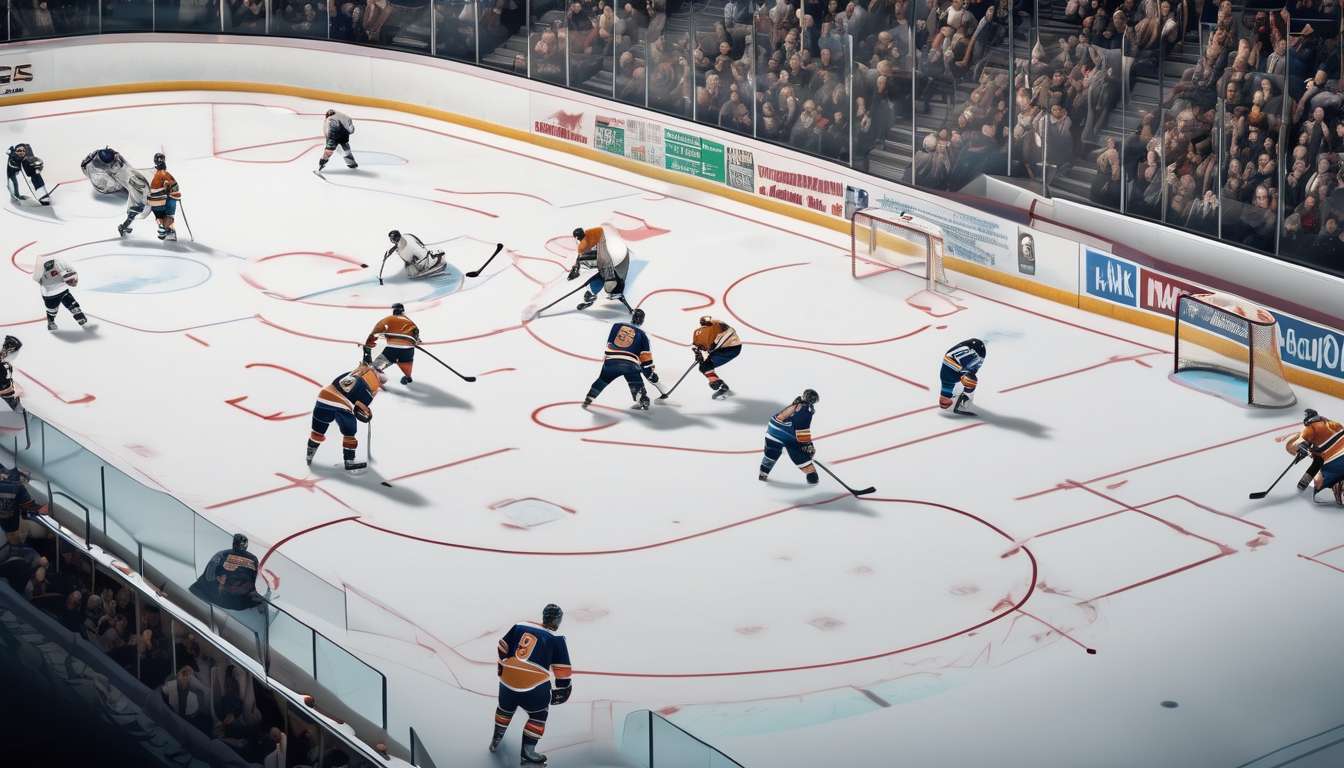As avid fans and dedicated researchers of the National Hockey League (NHL), we are constantly seeking to deepen our understanding of the game we love. Over the years, we’ve sifted through vast amounts of data, analyzed countless games, and engaged with experts across the hockey world to uncover the most effective methods for researching NHL games.
Our journey has led us to refine our techniques, ensuring that each analysis is grounded in proven strategies that enhance our insights into:
- Team dynamics
- Player performance
- Game outcomes
By combining statistical analysis with qualitative observations, we aim to provide a comprehensive approach that not only captures the excitement of the game but also reveals the underlying factors that drive success on the ice.
In this article, we will share these proven methods with you, offering a roadmap for anyone eager to delve deeper into the intricacies of NHL game research.
Understanding Team Strategies
To effectively analyze NHL team strategies, we need to delve into their tactical approaches and game dynamics. By understanding how teams operate, we can foster a deeper connection to the sport we love.
Each team crafts its unique strategies by adapting to:
- Player strengths and weaknesses
- Opposition’s tendencies
We can observe these strategies in action during games, where the flow and decision-making reveal much about a team’s approach.
Key to our analysis is the use of player statistics and advanced metrics. These tools allow us to break down complex strategies into understandable segments.
For example, metrics like:
- Corsi and Fenwick: Help gauge puck possession
- Zone entries and exits: Provide insight into a team’s transitional play
By examining these elements, we gain a clearer picture of what makes a team successful or where they might struggle.
Let’s immerse ourselves in this strategic exploration, enhancing our appreciation and understanding of the game together.
Analyzing Player Statistics
Let’s dive into the world of player statistics to uncover the individual performances that drive team success. As fans, we’re part of a community that thrives on understanding how each player’s contributions align with team strategies. By examining player statistics, we can appreciate the nuances that aren’t always visible during a fast-paced game.
Basic Metrics:
- Goals
- Assists
- Plus/Minus Ratings
Advanced Metrics:
-
Corsi and Fenwick: These offer deeper insights into a player’s impact on puck possession and shot attempts, crucial elements in a team’s game plan.
-
Player Efficiency Ratings: These assess how effectively players contribute to scoring opportunities relative to their ice time.
Together, these statistics paint a comprehensive picture of how individual performances integrate into a cohesive team effort. By delving into these numbers, we strengthen our connection to the game and each other, enhancing our shared experience as part of the larger hockey community.
dissecting Game Tactics
In our quest to understand the intricacies of hockey, let’s break down the game tactics that shape each match on the ice. We know that team strategies are the backbone of any successful NHL team. Whether it’s a defensive setup, like the neutral zone trap, or an aggressive forecheck, these strategies dictate the flow of the game.
We’ve seen how player statistics contribute to these tactics, guiding coaches in making informed decisions about line combinations and in-game adjustments.
By examining advanced metrics, we can see which strategies are truly effective. Metrics like Corsi and Fenwick help us evaluate:
- Puck possession
- Shot attempts
These metrics offer insights into a team’s offensive prowess.
Team cohesion is crucial, and understanding these tactics together strengthens our bond as fans. As we dive deeper, it’s important to remember that the essence of hockey lies not just in individual skills but in the collective execution of well-planned strategies on the ice.
Utilizing Advanced Metrics
Harnessing Advanced Metrics for Deeper Insights
In our community of NHL enthusiasts, we understand the power of numbers in revealing the intricacies of hockey. By analyzing advanced metrics, we gain a clearer picture of team strategies and their evolution throughout the season.
Key Metrics for Team Performance
- Corsi and Fenwick: These metrics help evaluate puck possession, providing insights into which team controls the game.
- Expected Goals (xG): Offers a deeper understanding of scoring chances and overall offensive effectiveness.
Assessing Individual Contributions
We can utilize player statistics to measure individual contributions beyond traditional stats like goals and assists. Advanced metrics consider various factors:
- Zone Entries: Evaluates how effectively a player enters the opponent’s zone.
- Shot Quality: Assesses the quality of shots taken by a player, providing insights into scoring potential.
- Defensive Effectiveness: Measures a player’s impact on preventing goals and disrupting the opponent’s plays.
Building a Data-Driven Connection
By embracing these metrics, we strengthen our connection to the game and each other, sharing a deeper, data-driven understanding. This approach allows us to appreciate the beautiful complexity of hockey with fresh eyes and brings us closer together as a community.
Studying Historical Data
Examining historical data allows us to uncover patterns and trends that have shaped the evolution of the NHL over the years. By diving into decades of player statistics and team strategies, we can gain valuable insights that unite us with fellow enthusiasts who share our passion for the game.
Through this exploration, we see how advanced metrics have transformed our understanding of hockey, highlighting the subtle dynamics that drive team success.
As we analyze these rich archives, we get to appreciate how past strategies have paved the way for modern tactics. By comparing the stats of legendary players to current stars, we not only celebrate the sport’s history but also find connections that bind us as a community.
Together, we can identify the impact of various playing styles and how they’ve evolved, giving us a deeper appreciation for the game’s progression.
Ultimately, studying historical data brings us closer, nurturing our shared love for hockey and its ever-evolving narrative.
Engaging with Hockey Experts
Engaging with hockey experts offers a unique opportunity to deepen our understanding of the game through their insights and experiences. These experts, often composed of former players, coaches, and analysts, provide valuable perspectives on:
- Team strategies
- Player statistics
- Advanced metrics
By connecting with them, we enhance our knowledge and become part of a community that shares our passion for NHL research.
Team Strategies:
Experts can break down the nuanced decisions that influence a game’s outcome. Their analysis helps us see beyond the surface and appreciate the complexity of each play.
Player Statistics:
Experts highlight the stories behind the numbers, making data more relatable and impactful.
Advanced Metrics:
Although these can seem daunting, expert guidance turns them into powerful tools for understanding the game’s intricacies.
By engaging with these knowledgeable individuals, we’re not just learning; we’re joining a network of enthusiasts dedicated to exploring the depths of hockey.
Tracking In-Game Trends
In tracking in-game trends, we focus on identifying patterns and shifts in gameplay that can reveal crucial insights into a team’s performance. By closely examining team strategies, we can understand how teams adapt during critical moments and what tactics lead to success.
Our approach involves analyzing player statistics, which helps us pick up on individual contributions that might otherwise go unnoticed. It’s about seeing beyond the obvious and appreciating every player’s role in the bigger picture.
We also delve into advanced metrics to provide a more nuanced view of the game. These metrics help us capture the subtleties of game dynamics and uncover trends that traditional statistics might miss. By leveraging these tools, we create a shared understanding of the game’s evolving nature, fostering a sense of belonging among those who love the sport.
Together, we’re not just spectators; we’re part of a community that appreciates the depth and complexity of hockey, always eager to uncover the next trend.
Incorporating Video Analysis
We dive into video analysis to gain visual insights that enhance our understanding of gameplay intricacies. As devoted fans and analysts, we gather to break down footage, dissecting every play to uncover the underlying patterns in team strategies. By watching games closely, we can see how skaters position themselves, adapt to opponents, and execute game plans. This shared experience strengthens our community, as we discuss and debate our observations.
Video analysis also allows us to marry visual data with player statistics and advanced metrics. We don’t just rely on numbers; we verify them against real-world actions. For instance, we might notice a player’s improved performance isn’t merely a statistical fluke but a result of strategic adjustments on the ice. By combining these elements, we build a more comprehensive picture of the game, enhancing our appreciation and understanding.
Together, as a united group, we thrive on these insights, deepening our connection to the sport we love.
What are some common injuries in NHL games and how do they affect players’ performance?
In NHL games, common injuries such as concussions, sprains, and fractures can significantly impact players’ performance. These injuries often lead to players missing games, which in turn affects team dynamics and strategies.
Concussions, in particular, can have long-term consequences on players’ cognitive abilities and overall well-being. This makes it especially important for teams to address these injuries with urgency and care.
It’s crucial for teams to prioritize player safety and provide proper medical care to ensure:
- Players’ health
- Optimal performance on the ice
By taking these steps, teams can help mitigate the negative effects of injuries on both individual players and the team as a whole.
How does fan engagement and support influence team performance during the NHL season?
We believe that fan engagement and support play a crucial role in influencing team performance during the NHL season.
When fans are actively involved and show unwavering support for their team, it can boost morale and motivate players to perform at their best.
The energy and enthusiasm from the crowd can create a positive atmosphere that can uplift the team and drive them towards success on the ice.
What are the financial implications of a team’s success or failure in the NHL?
When a team succeeds or fails in the NHL, there are significant financial implications.
Revenue Sources:
- Ticket sales
- Merchandise
- Sponsorships
Impact of Winning:
- Attracts more fans
- Increases sales
- Boosts partnerships
Impact of Losing:
- Decreases attendance
- Reduces fan engagement
- Results in financial losses
The financial health of a team is closely tied to its success on the ice.
Conclusion
In conclusion, by delving into team strategies, player statistics, game tactics, advanced metrics, historical data, expert insights, in-game trends, and video analysis, your NHL game research will be thorough and insightful.
Keep up the great work and stay dedicated to honing your research skills to gain a deeper understanding of the game.
Happy researching and best of luck in your analysis!

